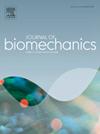Predicting anterior tibial translations in pediatric ACL-deficient knees with finite element knee models
IF 2.4
3区 医学
Q3 BIOPHYSICS
引用次数: 0
Abstract
Anterior cruciate ligament (ACL) injuries frequently occur in young individuals. However, knee biomechanics in this population, especially among adolescents, are poorly understood. The purpose of this study was to use finite element (FE) knee models to investigate anterior tibial translations during the Lachman test (LT) and pivot shift test (PST) in ACL-deficient pediatric knees. Computed tomography scans from 22 subjects (aged 9–18 years; 6 females, 16 males) were used to create FE knee models. Cadaveric, experimental data of ACL-deficient knees were used to validate the accuracy of the models’ anterior tibial displacement predictions. Simulated anterior tibial translations for the LT (21.2 mm at 134 N) and PST (7.0 mm) showed no significant differences from the experimental cadaver results (p = 0.37; p = 0.46), confirming model validity. Comparisons with ACL-intact, baseline models revealed significantly increased anterior tibial displacements in ACL-deficient knees under identical loading conditions (p < 0.001), emphasizing the ACL’s stabilizing role in both translation and rotational mechanics. The study demonstrates the use of FE methods to simulate physiologically relevant pediatric knee biomechanics and highlights their potential as a preclinical tool for evaluating the biomechanical effects of surgical techniques and rehabilitation interventions. In doing so, this study provides insight into the development of personalized treatment strategies, further supporting clinical advancements in this understudied demographic.
用有限元膝关节模型预测儿童acl缺失膝关节的胫骨前移位
前交叉韧带(ACL)损伤经常发生在年轻人。然而,在这一人群中,尤其是在青少年中,膝关节生物力学知之甚少。本研究的目的是使用有限元(FE)膝关节模型来研究在Lachman试验(LT)和枢轴移位试验(PST)中acl缺陷儿童膝关节的胫骨前移位。计算机断层扫描22名受试者(年龄9-18岁;女性6例,男性16例)制作FE膝关节模型。用acl缺失膝关节的尸体实验数据验证模型胫骨前移位预测的准确性。LT (134 N时21.2 mm)和PST (7.0 mm)的模拟胫骨前移位与实验尸体结果无显著差异(p = 0.37;P = 0.46),证实了模型的有效性。与完整的acl相比,基线模型显示,在相同的载荷条件下,缺乏acl的膝关节胫骨前移位明显增加(p <;0.001),强调前交叉韧带在平移和旋转力学中的稳定作用。该研究展示了使用有限元方法来模拟与生理相关的儿童膝关节生物力学,并强调了它们作为评估手术技术和康复干预的生物力学效果的临床前工具的潜力。在此过程中,本研究为个性化治疗策略的发展提供了见解,进一步支持了这一未被充分研究的人群的临床进步。
本文章由计算机程序翻译,如有差异,请以英文原文为准。
求助全文
约1分钟内获得全文
求助全文
来源期刊

Journal of biomechanics
生物-工程:生物医学
CiteScore
5.10
自引率
4.20%
发文量
345
审稿时长
1 months
期刊介绍:
The Journal of Biomechanics publishes reports of original and substantial findings using the principles of mechanics to explore biological problems. Analytical, as well as experimental papers may be submitted, and the journal accepts original articles, surveys and perspective articles (usually by Editorial invitation only), book reviews and letters to the Editor. The criteria for acceptance of manuscripts include excellence, novelty, significance, clarity, conciseness and interest to the readership.
Papers published in the journal may cover a wide range of topics in biomechanics, including, but not limited to:
-Fundamental Topics - Biomechanics of the musculoskeletal, cardiovascular, and respiratory systems, mechanics of hard and soft tissues, biofluid mechanics, mechanics of prostheses and implant-tissue interfaces, mechanics of cells.
-Cardiovascular and Respiratory Biomechanics - Mechanics of blood-flow, air-flow, mechanics of the soft tissues, flow-tissue or flow-prosthesis interactions.
-Cell Biomechanics - Biomechanic analyses of cells, membranes and sub-cellular structures; the relationship of the mechanical environment to cell and tissue response.
-Dental Biomechanics - Design and analysis of dental tissues and prostheses, mechanics of chewing.
-Functional Tissue Engineering - The role of biomechanical factors in engineered tissue replacements and regenerative medicine.
-Injury Biomechanics - Mechanics of impact and trauma, dynamics of man-machine interaction.
-Molecular Biomechanics - Mechanical analyses of biomolecules.
-Orthopedic Biomechanics - Mechanics of fracture and fracture fixation, mechanics of implants and implant fixation, mechanics of bones and joints, wear of natural and artificial joints.
-Rehabilitation Biomechanics - Analyses of gait, mechanics of prosthetics and orthotics.
-Sports Biomechanics - Mechanical analyses of sports performance.
 求助内容:
求助内容: 应助结果提醒方式:
应助结果提醒方式:


